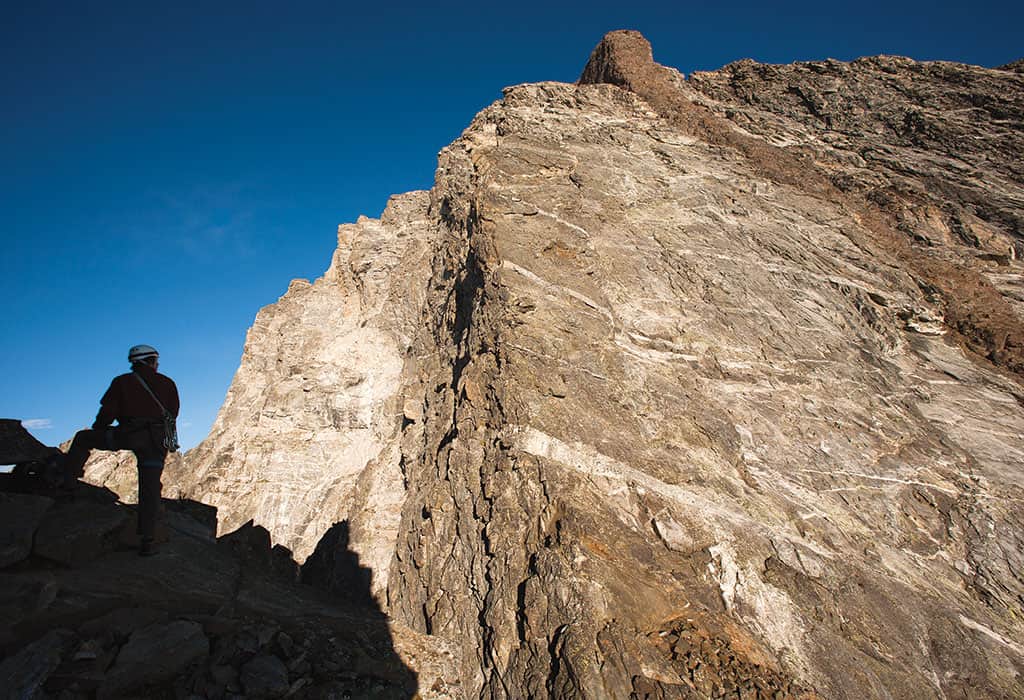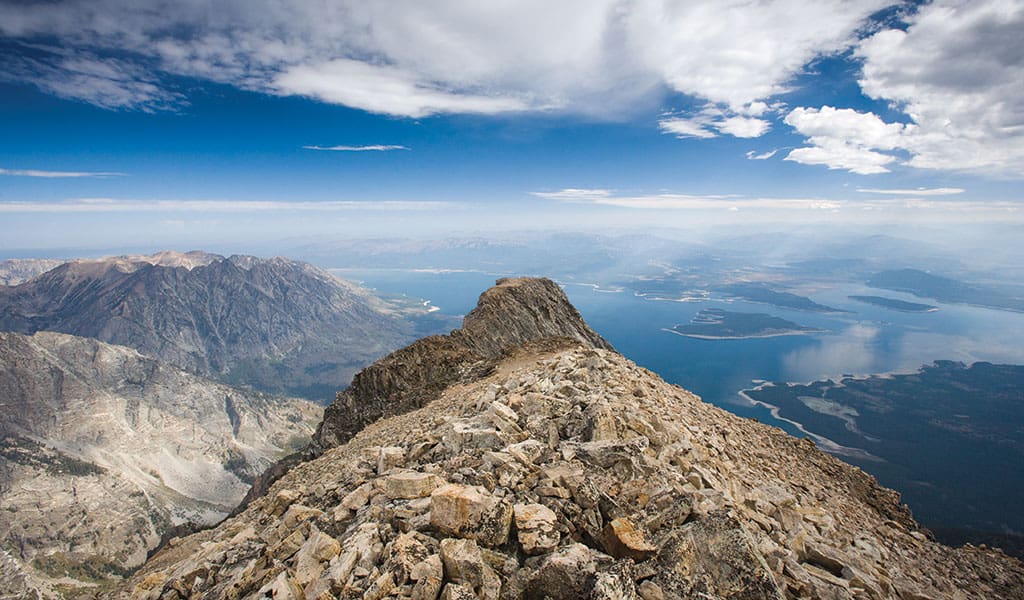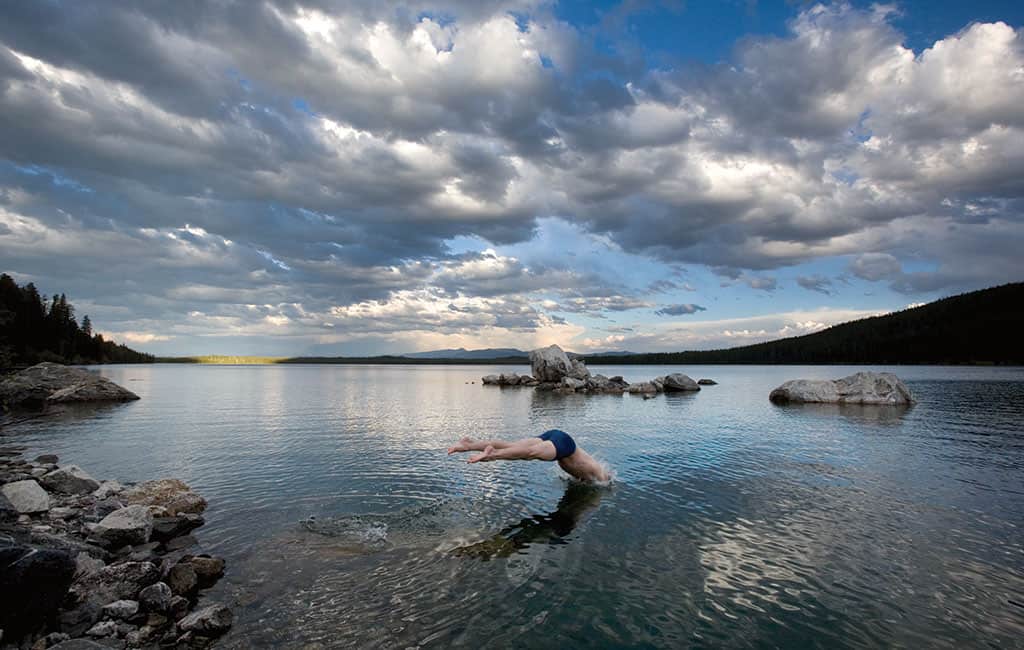Read The
Current Issue
Solitude on a Summit
Mount Moran isn’t as iconic as the Grand Teton, but in many ways it is the better adventure.
BY Frederick Reimers
PHOTOGRAPHY BY david stubbs

ONCE YOU SPOT Mount Moran, you can’t peel your eyes from it. It dominates Jackson Hole’s northern skyline, a shimmering gray monolith split down the middle by lightning bolts of icy glaciers. In 1918, after a media team from Scientific American visited the peak, they wrote: “The summit has never been attained and probably never will, as the last 3,000 feet of the mountain are sheer perpendicular walls of rock.” That prediction would last just four years, but you can forgive them for thinking so. From the valley floor, the peak’s sheer flanks appear as impregnable as the hull of a battleship. As with most mountains, though, approach nearer and the suggestion of a way appears. Make the proper effort, and the summit is attained. Had the 1918 party trailed us up Moran’s southeast face last summer, they probably would have reached the summit just fine, old-fashioned, clunky gear and all.
Though just an occasional climber, I’ve eyed the peak for twenty years, wondering what the top of its squared-off summit looks like. But like most climbers who arrive in Jackson Hole, I first wanted to tackle the Grand Teton. I’ve made that summit a few times, but there’s always a caveat—in midsummer, it’s a virtual conga line. Not only is the climbing crowded, but it can be impossible to get a permit to camp anywhere near the easiest routes up it. Many people find it necessary to skip the sleeping altogether; they start up the 7,000-foot ascent at midnight, and then stumble, zombie-like, all the way back down late that afternoon with pummeled, aching knees.
A modest suggestion: Go for Moran instead—camping permits are easy to score, you’ll have plenty of solitude on the route, and there’s actually more technical climbing to be had on it than on the most popular routes up the Grand. The 12,605-foot peak goes at a modest 5.5 rating, suitable for most anyone who has ever slipped on a pair of climbing shoes, and Exum Mountain Guides tells clients that so long as they can complete a ten-mile run, they’ll be fit enough to enjoy the expedition.
ON SEPTEMBER 1 of last year, I join Exum co-owner Nat Patridge for a two-day, one-night trip up Mount Moran’s CMC route. We meet at noon at Exum’s office in Grand Teton National Park, load a canoe onto the roof of my truck, and drive to the String Lake Trailhead. You can reach the base of the CMC on foot, but why not let a canoe carry the load?
We paddle across String and then Leigh lakes. It’s a warm, cloudless day, and we stop on the water so Patridge can point out the route—a steep hike to camp in a stand of trees about halfway up the 5,728-foot climb. A thousand feet above that is the route’s peculiar feature: You descend a 150-foot-high cliff, named Drizzlepuss, to the 5.5 slabs that lead to the summit. Climbing back up Drizzlepuss on your way down is actually the route’s hardest element.
“I had to bail off Moran a few weeks ago because we saw a storm coming over the ridge—hail and lightning,” Patridge says. “The clients were disappointed.” Luckily our forecast calls for clear weather.
We land the canoe at the base of the peak next to a steep creek tumbling down from the Falling Ice Glacier, several thousand feet above. We toss our packs onto shore, secure the canoe, and then sink some beers in the creek for the return trip. The trail is as steep as a flight of stairs, a continuous jumble of suitcase-size rocks. After an hour of steady going, we sit beside the creek and drink water, looking down at the blue lake below.
At 6 p.m. we arrive at camp, a series of terraced tent sites amongst a grove of whitebark pine trees. A few people are there, packing up their gear from the night before and preparing to head down the mountain. “Anyone want some mayo packets?” one of them asks, apparently trying to shed weight. I take them, why not? They can’t make my freeze-dried backpacker meal any worse. Once they clear out, we’ve got the entire mountain to ourselves.

THE NEXT MORNING we wake an hour before dawn and begin our ascent by headlamp, scrambling up a series of craggy ledges between trees. When the sun begins to rise, the low, groggy feeling of waking in the dark finally lifts, and I turn to admire the glossy pewter color that the lakes below begin to show. I’ve finally built up enough heat to remove my puffy outer layer. “There are some clouds, but very thin, spinning off the low pressure down to the west,” Patridge says. He is a meteorologist by necessity.
At 8 a.m. we arrive atop Drizzlepuss. We take a short break in the sun and put on our helmets and climbing harnesses—from here on, we will be roped together for the steep, technical terrain. We downclimb a few moves, and then rappel the rest of the cliff to a dark, windy notch. The Drizzlepuss name probably comes from the fact that, shaded by Moran’s bulk from the western sun, the cliff stays damp most of the summer.
Now begins the fun part. For the next two hours Patridge leads the way, trailing a rope behind him up the steep, sun-warmed rock. Every once in a while he jams a nut into a crack for protection, but more often simply slips a sling of webbing around a horn of rock. It’s old school, but fast and light—perfect for the moderate climbing. “It’s steep, with good edges,” he calls down on one pitch. I take my time, deliberately placing a hand, then a foot on the rock and hauling my weight upwards. The glacier spreads below us, a swath of white ice rimmed by gray rock. At one point, the wind cracks like the sound of a sail snapping as it slings around the edge of the mountain, something I’d never heard before.

We summit at 11 a.m., and find a rocky meadow, some fifteen acres in size. Black-capped rosy finches flit here and there, plucking insects from the ground. We stride around the summit for twenty minutes, taking in the view. We should have brought a Frisbee. To the east, the Snake River slashes southwards. To the west, it’s potato fields to the horizon. The Grand Teton lies directly south, and I imagine there are two dozen climbers clambering around each other atop its decidedly smaller summit.
On our descent, climbing down the same way we came, we cross paths with a trio of young pro skiers Nat and I both know. They are on a one-day push—they left home at midnight and still have a big day ahead—so after a minute’s conversation, they resume upwards. We reach our camp midafternoon, pack up the tent, and then descend along the creek. By the time we reach the lake, I’m ready to get off my feet for a few days, and welcome a plunge in the cool water. Before we paddle home, though, we decide to prank the boys and tie their canoe to a pile of rocks a short swim off shore. We leave them a few beers for their trouble, and make our way home, pretty well pleased with ourselves.
NUTS & BOLTS
To book a two-day guided ascent of Mount Moran, make a reservation with Exum Mountain Guides. The trip costs $1,600 for a single person or $2,600 for a pair. Meals are not included. 307/733-2297, exumguides.com





